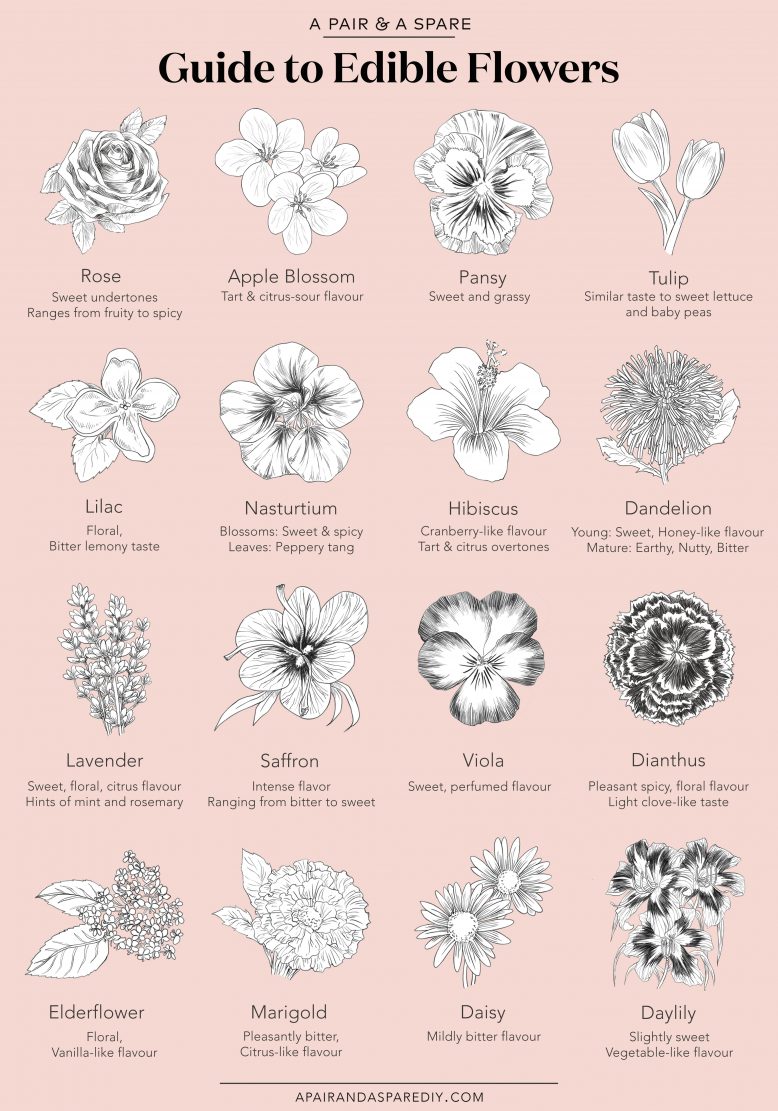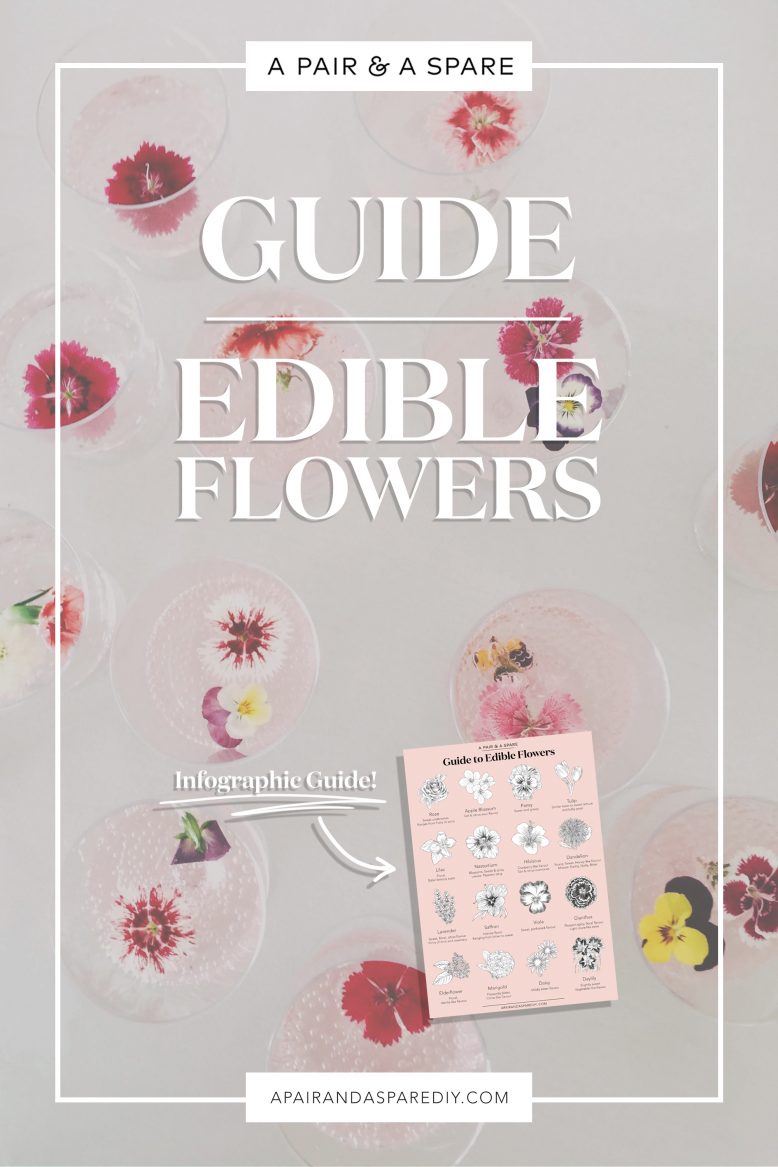Hey guys! Ready to start adding flowers to every meal? I know I am…
You’ll be unsurprised that I’m a lover of all things floral, and recently this obsession has taken a bit of a gastronomic turn… After researching the field of eating flowers for ages, and mining all our florist friends for an much info as we could, we learnt soooo much! Like the fact that only some flowers are edible and that different flowers have very different flavours. Turns out edible flowers are both a science and an art. Who knew? Read on for a distillation of what we learnt.
A Guide to Edible Flowers
Below is our guide to edible flowers. It’s important to note that not every flower is edible, so we’ve listed our favorites below. In addition, in order for a flower to be safe for eating, it needs to have been grown organically and without pesticides. If you have a garden it’s a great idea to purchase the seeds and grow them yourself (so much satisfaction!), otherwise look for them in specialty grocery stores or health food stores.
Apple Blossom
Flavour Apple blossom has a delicate tart and citrus-sour flavour.
Pair with Goes well with salads or as a garnish after the petals are candied.
TAKE NOTE Apple fruit seeds and wild apple blossoms are poisonous.
Rose
Flavour The petals of roses have a delicate flavour which ranges from fruity to spicy over a sweet undertone, depending on the type of rose and color intensity. The more intense the color, the stronger the flavour.
Pair with Rose petals bring a freshness to drinks and salads. You can also make a rose petal jam out of them!
TAKE NOTE Remember to remove the white parts from the base of the petals before consumption.
Pansy
Flavour Also known as Viola x Wittrockiana, pansies have a sweet green and grassy flavour.
Pair with Add them into salads, or crystallise them for a decorative garnish on cakes or creamy desserts.
Tulip
Flavour Tulip petals have a crisp texture and sweet lettuce or pea-like flavour.
Pair with Add tulip petal strips to salads or sandwiches for a touch of color and flavour.
TAKE NOTE Remember to remove the pollen and stigmas before adding tulips to your food. Some people have allergic reactions to tulips, if you experience rashes or numbness by touching tulips, do not eat them.
Lilac
Flavour Lilacs have a distinct bitter, lemony taste.
Pair with Mix them with cream cheese over crackers, or add to yoghurt for a lemony tang. They can also be crystallised and mixed with egg-white and sugar for dessert toppings.
Nasturtium
Flavour The entire flower can be eaten, with the blossoms of the nasturtium tasting of a sweet, spicy flavour, while the leaves have a peppery tang.
Pair with They add a hint of spiciness when mixed with salads, or chopped up and used as garnish.
Hibiscus
Flavour Hibiscus petals taste like cranberry and have a tart and citrus flavour.
Pair with Add strips of hibiscus petals to salads for taste and color, or dry the petals out for a citrus-flavoured tea.
Dandelion
Flavour Young daisies have a sweet and honey-like flavour, whilst the mature ones are more bitter and earthy, with a nutty flavour. Dandelion buds taste better than the actual flower.
Pair with Use the petals as a garnish in desserts, salads or savoury dishes.
Lavender
Flavour Lavender has a sweet, floral, citrus flavour, with hints of minty and rosemary-like aromas.
Pair with Make lavender sugar and add it to sorbets, jams or jellies. Sprinkle some into vegetable stock to create a sauce for meat dishes, or add some into stews or wine-reduced sauces for an extra dash of flavour.
TAKE NOTE Lavender oil may be poisonous. Do not add to food for consumption.
Saffron
Flavour The only part of the saffron flower that is used in food is the distinctive red stigma. (Two other cheaper alternatives to saffron are turmeric and safflower.) It creates a distinctive golden color in dishes, and the flavour varies depending on where the flower is grown. It’s also known to taste differently for different people, but it has an intense flavour that ranges from bitter to sweet.
Pair with Saffron pairs especially well with seafood, mostly in the sauces. Add saffron into the sauce whilst cooking, and add it to the finished dish right before serving. Add it into bouillabaisse, paella and risottos.
Viola
Flavour This flower has a sweet, perfumed flavour, with a taste that’s similar to lettuce.
Pair with Add viola to salads for extra flavour and color, or crystallise and add to cake, desserts or iced drinks for decoration.
TAKE NOTE Not all Viola flowers are safe for eating: Only Viola cornuta, Viola hybrida, Viola tricolor, Viola x williamsiana,Viola x Wittrockiana (Pansy) and Viola odorata are edible.
Dianthus
Flavour Also known as carnations. Most of these flowers have a pleasant spicy, floral flavour, and a light clove and nutmeg-like taste.
Pair with They can add color to dishes when used as a garnish for desserts, soups, salads. Or you can even steep them in a glass of wine for an extra zesty taste.
TAKE NOTE Remember to cut away the bitter white base of the flowers before eating.
Elderflower
Flavour Has a floral, vanilla-like taste.
Pair with Most commonly used to create Elderflower cordial, and also makes a nice garnish over desserts or drinks. They can also be dried out and steeped in hot water to make Elderflower tea.
Marigold
Flavour Marigolds have a similar taste to saffron, with a pleasantly bitter, citrus-like flavour, thus it’s also known as the “Poor Man’s Saffron”, since it’s more readily available and cheaper compared to saffron.
Pair with Add them to salads, sandwiches or hot desserts for extra zest.
TAKE NOTE Only the petals are edible, and marigolds may be harmful when taken in large amounts, consume only occasionally and in moderation.
Daisy
Flavour Daisies have a mildly bitter flavour.
Pair with Daisies are mostly used as decorations and garnishes, and can be dried out to make daisy flower tea.
Day Lily
Flavour Day lilies have a sweet, slightly vegetable-like flavour.
Pair with The petals are a good addition to salads and soups, and can be added to stir-fries and even cooked and eaten as a vegetable.
TAKE NOTE Also known as Tiger Lilies, Day Lilies from the Hemerocallidoideae family are edible, the ones from the Liliaceae family, also known as Tiger Lilies, are poisonous and definitely should not be consumed.
Armed with all that info, you can no go forth and eat your flowers!
Photos of flower cocktails and cake taken at a Molten Store event. Illustrations by Natalie Ong.























